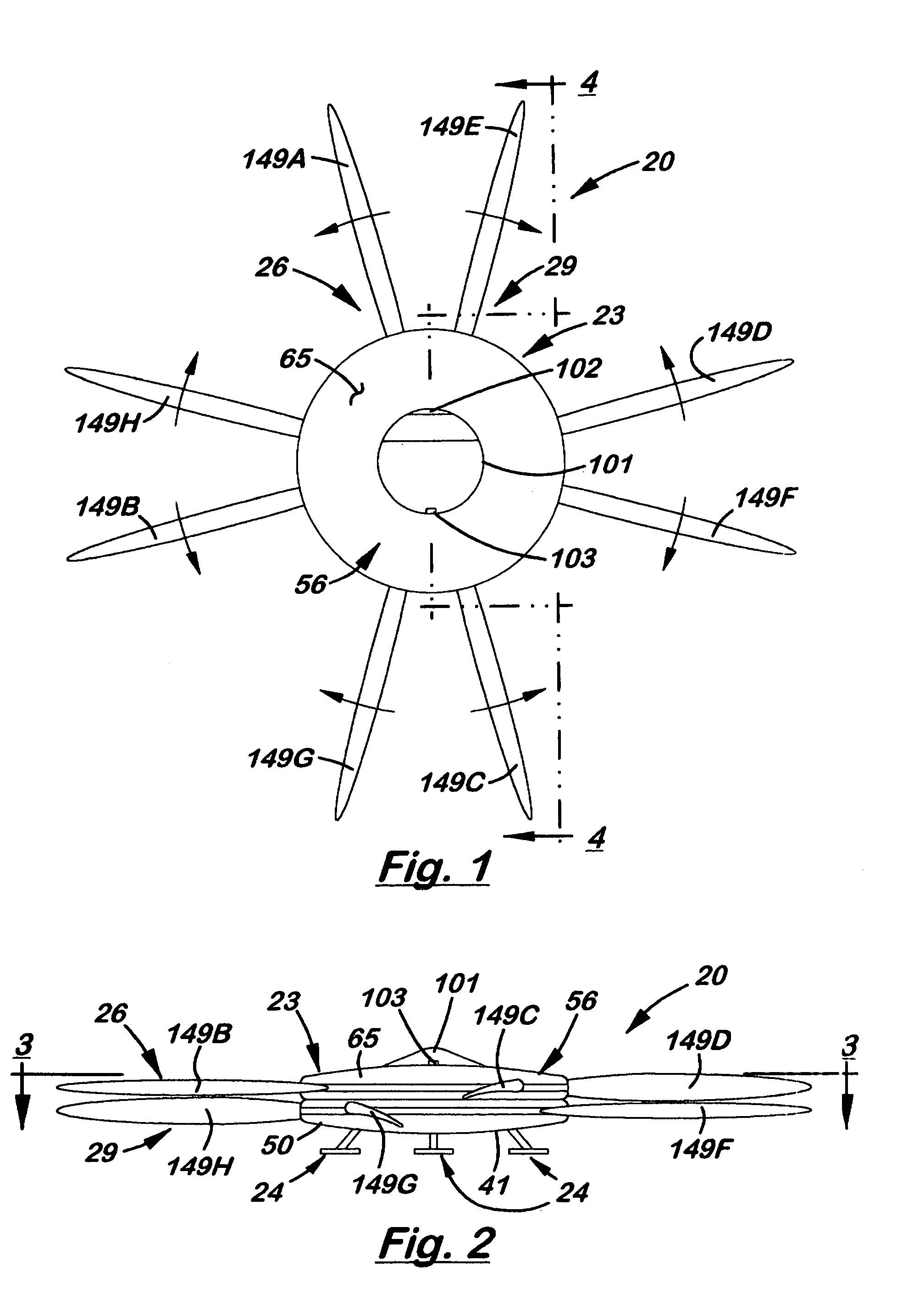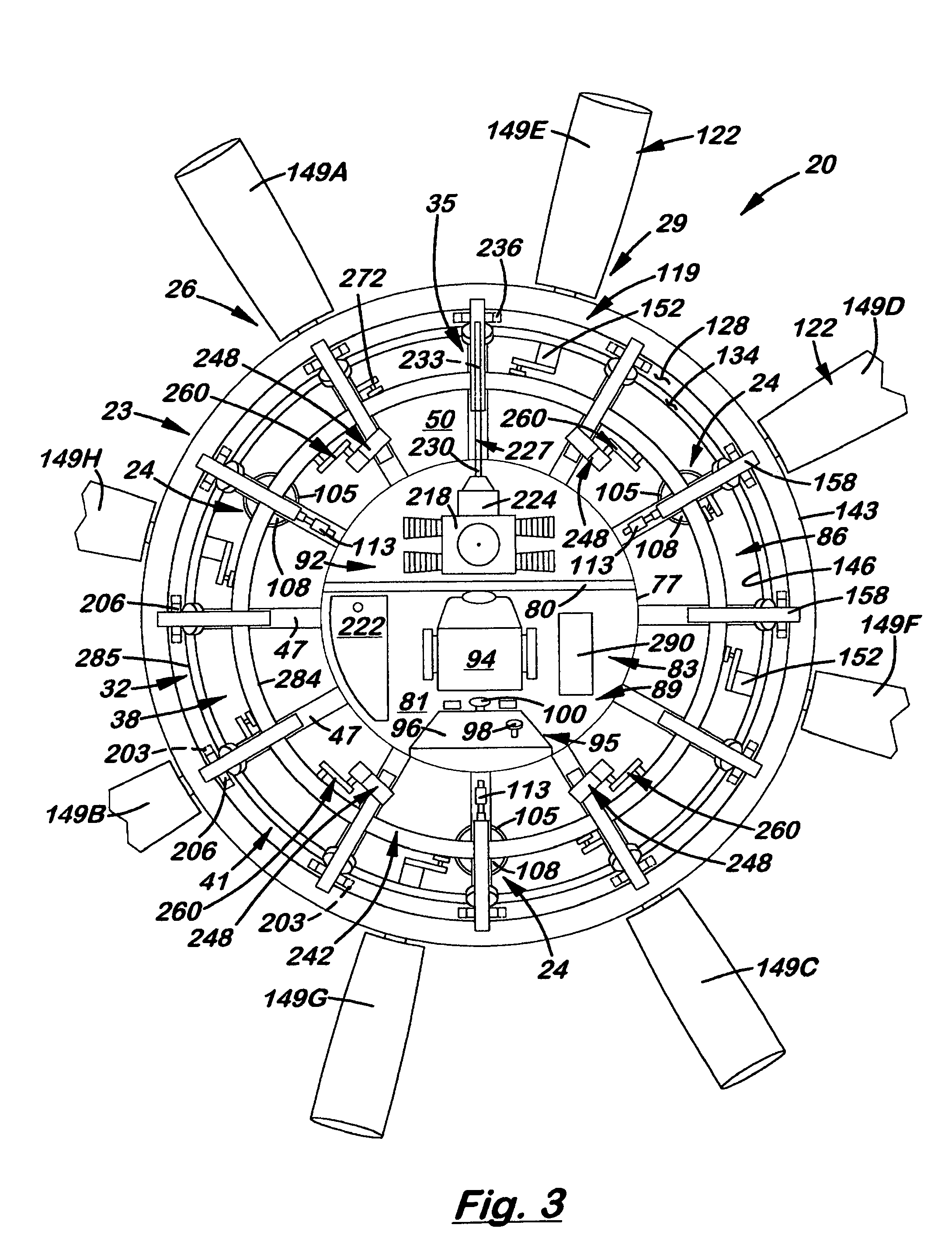Rotorcraft having coaxial counter-rotating rotors which produce both vertical and horizontal thrust and method of controlled flight in all six degrees of freedom
a rotorcraft and rotor blade technology, applied in the field of helicopters, vertical takeoff and landing aircraft, can solve the problems of lack of controllability, complex control mechanism required to change the pitch of the main rotor blade, and no prior art helicopters, rotorcrafts and aircraft are capable of fligh
- Summary
- Abstract
- Description
- Claims
- Application Information
AI Technical Summary
Benefits of technology
Problems solved by technology
Method used
Image
Examples
first embodiment
[0055]Referring to FIGS. 1–6, therein is shown a first embodiment rotorcraft in accordance with the present invention which provides controlled flight in all six degrees of freedom, designated generally at 20. The rotorcraft 20 includes a fuselage 23, a plurality of landing gear 24, and a rotor system comprised of a pair of counter-rotating upper and lower rotor blade assemblies 26 and 29, a rotor support assembly 32, a rotor drive system 35, and a rotor blade pitch control system 38.
[0056]The fuselage 23 shown is of a substantially circular shape as viewed from above and below, though other configurations are possible including elongate versions having multiple pairs of rotor blade assemblies 26 and 29 which are longitudinally or laterally spaced thereon. The fuselage 23 includes a circular lower frame 41 comprised of a lower annular frame 44 from which a plurality of radially-extending tapered floor beams 47 of an I-beam cross-section extend covered by a lower skin 50. The annular...
second embodiment
[0100]The precise individual control of the vertical and horizontal thrust components of each blade 149 (even more independently controllable in the second embodiment following) allows the pilot of the rotorcraft 20 to compensate for turbulence, and varying wind conditions such as wind gusts. For example, if a prevailing wind is present prior to take-off which could lift the upwind side of the rotorcraft 20 during take-off and possibly flipping over the rotorcraft 20, a small amount of negative pitch angle my be applied to the blades 149 A–D and E–H passing through the upwind of sector of the rotorcraft 20 prior to take-off while warming up the engine 218 to keep the rotorcraft 20 firmly on the ground. Upon lift-off and flight of the rotorcraft 20, positive and negative pitch angles may be utilized to compensate for prevailing wind, wind gusts, and any other undesired wind interference regardless of the speed, direction, attitude, or proximity to obstacles encountered during flight....
third embodiment
[0107]Referring to FIGS. 29–34, therein is shown a third embodiment rotorcraft 329 in accordance with the present invention which provides controlled flight in all six degrees of freedom. The rotorcraft 329 comprises the circular fuselage 23, the plurality of landing gear 24, a pair of counter-rotating rotor blade assemblies 332 and 335, the rotor support assembly 32, the rotor drive system 35, and a rotor blade pitch control system 338 which is the same as rotor blade pitch control system 38 except for a different controller in the form of a computer 341, and thus not further explained.
[0108]The rotor blade assemblies 332 and 335 each include a pair of the gear rings 119 and a plurality of blade assemblies 344. The rotor blade assemblies 344 each include a plurality of radially-extending airfoil shaped blades 347 fixedly mounted to the gear rings 125 at a fixed pitch about the respective longitudinal axes. The blades 247 are similar to blades 149 but with a flap slot 350 and respec...
PUM
 Login to View More
Login to View More Abstract
Description
Claims
Application Information
 Login to View More
Login to View More - R&D
- Intellectual Property
- Life Sciences
- Materials
- Tech Scout
- Unparalleled Data Quality
- Higher Quality Content
- 60% Fewer Hallucinations
Browse by: Latest US Patents, China's latest patents, Technical Efficacy Thesaurus, Application Domain, Technology Topic, Popular Technical Reports.
© 2025 PatSnap. All rights reserved.Legal|Privacy policy|Modern Slavery Act Transparency Statement|Sitemap|About US| Contact US: help@patsnap.com



